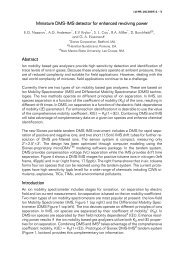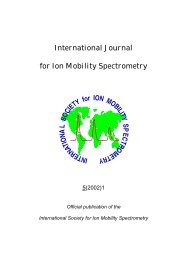DETECTION OF DMS USING HAND-HELD IMS - B & S Analytik GmbH
DETECTION OF DMS USING HAND-HELD IMS - B & S Analytik GmbH
DETECTION OF DMS USING HAND-HELD IMS - B & S Analytik GmbH
- No tags were found...
Create successful ePaper yourself
Turn your PDF publications into a flip-book with our unique Google optimized e-Paper software.
<strong>DETECTION</strong> <strong>OF</strong> <strong>DMS</strong> <strong>USING</strong> <strong>HAND</strong>-<strong>HELD</strong> <strong>IMS</strong>Johannes Flachowsky, Michaela Brodacki, Joachim StachABSTRACTThe paper describes an analyticalmethod for on-site detection of <strong>DMS</strong> (DiMethyl Sulfate) using ion mobilityspectrometry (<strong>IMS</strong>). The ion mobility spectraof <strong>DMS</strong> recorded in the negative mode show asingle peak with a reduced ion mobilityconstant k 0 = 1.96 cm 2 /Vs. Using this signal,it is possible to measure <strong>DMS</strong> in the range of 5to 100 ppb/m 3 . The detection limit determinedunder laboratory conditions is 3ppb.Interference of matrix compounds likecoolants have been detected but can bemanaged using simple sample preparationprocedures.INTRODUCTION<strong>DMS</strong> is an important component forsynthesis of chemical compounds. It isproduced in large quantities. Due to the hightoxicity [1], the production of <strong>DMS</strong> ischaracterized by high security precautions.The tolerable values for the concentration of<strong>DMS</strong> are 0.1 mg/m 3 (20 ppb v ) in air and 0.2mg/m 3 (40 ppb v ) in the working placeatmosphere.The prescribed detection method for<strong>DMS</strong> according to the German: BGI 505-7 aretime consuming. The method is based onadsorption of <strong>DMS</strong> on TENAX followed byelution of the adsorbed <strong>DMS</strong> with methylacetate. The obtained solution is analyzedusing gas chromatography (GC) or GC/MS.The achieved absolute detection limits are inthe range of 3 ng <strong>DMS</strong>. The analysis time isabout 15 minutes.During the production process of <strong>DMS</strong>short term variations of the <strong>DMS</strong>concentration might occur which can exceedFigure 1: Series of ion mobility spectra of <strong>DMS</strong> (c= 19,6ppb) recorded in the negativeion modeReceived for review April 5, 2002, Accepted July 12, 2002
40 - <strong>DETECTION</strong> <strong>OF</strong> <strong>DMS</strong> <strong>USING</strong> <strong>HAND</strong>-<strong>HELD</strong> <strong>IMS</strong>Figure 2: Trend of the <strong>DMS</strong> peak with k 0 = 1.96 cm 2 /Vs demonstrating fast response andrecovery times of <strong>DMS</strong> detectionthe above given concentration limits. Thesevariations cannot be detected with theprescribed method due to required analysistime. Especially for this application on-lineanalysis methods like <strong>IMS</strong> [2,3] are requiredfor detection of <strong>DMS</strong>. In addition hand-held<strong>IMS</strong> does also support the safe handling of<strong>DMS</strong> in facilities, storage tanks etc.RESULTS<strong>DMS</strong> forms a single peak in thenegative mode with a reduced ion mobility ofk0 = 1.96 cm 2 /Vs. The detection is possiblewith short response and recovery times. Atypical series of ion mobility spectra is shownin Fig. 1. The trend for the <strong>DMS</strong> peak with k0= 1.96 cm 2 /Vs is displayed in Fig. 2. On-linedetection is possible with a very highsensitivity. The calibration curve is displayedin Fig. 3. The measured detection limit is 3ppb. The linear range of the calibration curveis between 3 and 40 ppb which fit therequired detection range for monitoring ofproduction facilities.The use of hand-held for detection of<strong>DMS</strong> in production facilities is simple andsafe. A very low number of interferingsubstances has been reported so far.However, in one particular case very highconcentrations of <strong>DMS</strong> were detected inunexpected parts of a production facilitywhere the risk for <strong>DMS</strong> contamination iscomparatively low. The signals showed a verylong response and recovery time contrary totypical <strong>DMS</strong> detection. A more detailedinspection showed that the strong <strong>DMS</strong>signals were caused by ethylene glycol. Acompound used as coolant. The detectedconcentration was about 2000 times higherthan <strong>DMS</strong> concentration. Considering theproperties of ethylene glycol, especially thehigh solubility in water, this interference canbe prevented using special filter which can beinstalled in front of the gas inlet of the <strong>IMS</strong>.References[1] Merk Chemie Datenbank 2002, http://www.chemdat.de[2] Eiceman, G.A.; Karpaz, Z.; Ion MobilitySpectrometry, CRC Press, Boca Raton, 1994.[3] Stach, J.; <strong>Analytik</strong>er Taschenbuch, Vol. 16,1997, 119.Copyright © 2003 by International Society for Ion Mobility Spectrometry
















